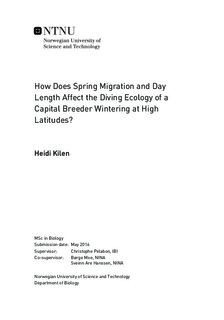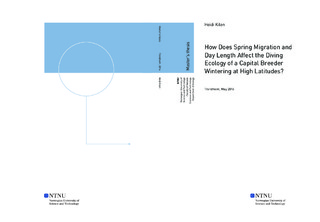| dc.description.abstract | Foraging strategies in animals are influenced by conflicting constraints such as migration, reproduction and seasonal changes in the environment. Sea ducks are capital breeders and rely on endogenous reserves for reproduction. Further, they are mainly diurnal feeders that feed on low-energy prey. There is little information on the diving behaviour of sea ducks around the time of spring migration, and on how they cope with decreasing day lengths in winter. I have studied the diving movements of common eiders (Somateria mollissima) breeding in Kongsfjorden, Svalbard and on Grindøya in northern Norway. The aim of this thesis is to investigate whether spring migration and day length affect the diving ecology of common eiders wintering in high latitude areas. To do this, I deployed time-depth recorders (TDRs) on 64 adult female common eiders during the breeding season in 2012-2014, and retrieved and successfully downloaded data from 20 TDRs. Data from these TDRs provided me with information on individual diving frequency, dive duration and dive depth, as well as light intensity and location. Two females from the Kongsfjorden population wintered in northern Norway, and the rest wintered in Iceland. The last two females were from the sedentary population at Grindøya. Comparisons of daily diving frequency before and after spring migration, revealed an effect of year, where eiders migrating in 2013 (n=5) showed no difference in diving frequency before and after migration. In 2014 (n=9) and 2015 (n=6) daily diving frequency was significantly higher after arrival on Svalbard, and the pooled average was also higher after spring migration. This suggests that female eiders prefer gaining weight after arriving on the breeding ground. Average dive depth did not differ before and after spring migration, which may indicate similarities in feeding habitat and prey choice. Averages on both hourly diving frequency and dive depth showed idiosyncratic variation throughout the non-breeding season, and dive depth was not affected by light intensity. This may further suggest a consistency in choice of feeding habitat. However, diving frequency increased significantly during daylight and twilight hours in the darkest period in winter. Nocturnal foraging also occurred in this period. This shows that female common eiders wintering at high latitudes are able to compensate for decreasing day lengths by increasing diving intensity in daylight and twilight, as well as extending their feeding period into the night. | |

